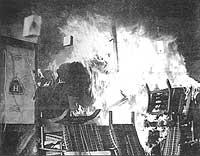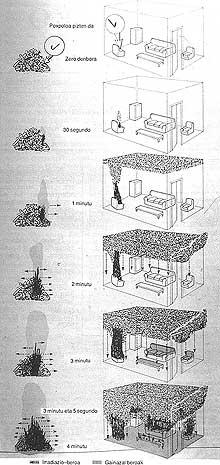Fires in homes
While the ease of ignition of materials when assessing fire risks is important, not everything ends there. The spread of fire includes many factors. Most of the heat is lost in the atmosphere and the fire grows regularly.
However, the fire inside the house is totally different. The geometry of the room (ceiling height, position of doors and windows) significantly influences the spread of fire. Imagine that a lit fence falls to the lounge chair and the tapestry arde. The flames are not bright and we do not realize that it has burned.
In thirty seconds, the material will emit smoke, combustion gases and heat. In another 30 seconds, they will reach the ceiling and will drift away. It will be extended forming a layer on the ceiling. This layer becomes more compact and warm as more material is burned.
In two minutes, the hot layer begins to shoot, returning to the burning element and to the other alisedas of the room.
In three minutes or, being the very intense thermal radiation, the whole stay reaches its point of inflammation, making everything a flame. From there the fire will not grow linearly and spread throughout life. If at that time there is someone in the room, he would have died.
For the inhabitants of other rooms of the house, the fire becomes dangerous. The fumes and toxic gases extend enormously through the doors to the bedroom and the entrance.
Ten seconds are enough to leave a room, but people do not realize the speed of fire and often lose time, such as going to the kitchen and filling a container with water. By the time the fire returns, it is oversized.
Death brings with it the dynamics of fire and the inadequate behavior of people. It is not just a matter of making materials flammable. In the Great London Fire of 1666 there were no deaths. Although the houses (mainly of wood) were easily burned, the fire spread gradually. People had enough time to see that the bonfire was and to flee.
On the other hand, the fire of the Bradford football field in 1985 caused the death of 56 people. Its tribune was made of wood (there it was not polyurethane), but due to the shape of the structure, the fire acquired great strength.
The fire began with the ignition of the baseness of the banks' basses. The cavity under the tribune acted as a room of the house, helping the fire to grow. Due to the cracks I had in the carpentry, air and flames could be introduced.
The smoke spread rapidly under the roof of the grandstand and the people below were going to radiate between 40 and 50 kilowatts per square meter. In a few seconds it burned and burned the skin. By the time people discovered the extent of the fire was too late. At first the fire was taken as fun. They had no idea of the deadly consequences of the heat radiating from the roof.
Even in a domestic fire people find it hard to react quickly. According to researchers, in some cases it may take five minutes to decide what to do. And that's too much, if we take into account that the fire completely occupies a room for three minutes.
It is mainly about fuels, beds and chairs and armchairs upholstered for many domestic fires. In these straighteners a lot of polyurethane is used. Smokers have tried many ways to make polyurethane safer. One of them is the polyurethane coating with a material that delays the flame. Another way is to change the foam, avoiding burning so fast.

The materials created by some companies are formed a hard layer on the surface of the foam when burning. This layer prevents the oxygen from entering the interior and delays its inflammation and the combustion process. The standard foam will be replaced next year by the following products. In their tests with these products it has been proven that they take between five and six times longer than normal foams to reach the highest temperature. This would give people more time to escape, but smoking slowly takes more time to detect the fire.
This type of foams, therefore, will be useful together with the smoke detector.
But these new products also have problems. The lighters mentioned above (armchairs, etc.) They should be soft and normally the lower the flammability of the material, the harder they are. Another problem is that they tend to break and bend, especially when doing.
Alisers will have to rearrange the product to find buyers.
In many of the accidents that occur in the home there are usually people who do not know what is happening or who cannot react immediately: often there are elderly or sick people, very young or intoxicated. In these cases it is not enough to stop the fire so that people have enough time to react.
Therefore, this type of foams should be tested in case of real fire and so it happens in the whole room. They must test their durability apart from fires. No one has bought and within a month (although it is very safe) wants to see a damaged sofa. Despite the fact that much importance has been given to the material change solution, fire researchers believe that other things can be done to avoid deaths, such as the installation of smoke detectors or the study of fire risks.
Perhaps the most important thing is to think of a program that educates people and especially children in the face of the dangers of fire. This program focuses on how to react in public places.
When synthetic foams were marketed for the first time, no one thought they were flammable or not. The consumer products were tested based on their normal function and not on fire function. Polyurethane looked like an ideal material for the manufacture of silks, soft, resistant and economical. However, as the materials have become more sophisticated and plastics have replaced traditional metals, manufacturers have been forced to carry out fire tests.







